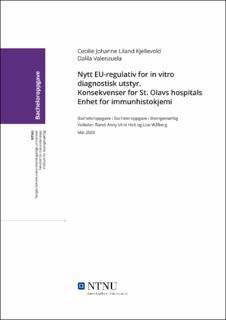| dc.contributor.advisor | Holt, Randi Anny Utne | |
| dc.contributor.advisor | Wålberg, Lise | |
| dc.contributor.author | Kjellevold, Cecilie Johanne Liland | |
| dc.contributor.author | Valenzuela, Dalila | |
| dc.date.accessioned | 2020-07-07T16:09:41Z | |
| dc.date.available | 2020-07-07T16:09:41Z | |
| dc.date.issued | 2020 | |
| dc.identifier.uri | https://hdl.handle.net/11250/2661299 | |
| dc.description.abstract | Norge samarbeider med EU (Den Europeiske Union) gjennom EØS avtalen. Denne avtalen gir Norge tilgang til markedet i EU, men samtidig også plikt til å følge direktiver og regulativer satt frem av EU.
Medisinske laboratorier i Norge benytter in vitro medisinsk utstyr (IVMU) til diagnostikk. EU direktiv 98/79/EC har vært det gjeldende regelverket for bruk og produksjon av IVMU. Direktivet inneholder retningslinjer for hvordan IVMU skal brukes og produseres, men hvordan disse retningslinjer følges har vært opp til hvert medlemsland. Siden bruk av IVMU kan ha direkte konsekvenser for diagnostikk og behandling av pasienter, ble det bestemt å innføre strengere regelverk. Derfor har EU vedtatt et regulativ som erstatter direktivet.
Dette nye regulativet kalles Europaparlamentet og Rådets Forordning (EU) nr. 2017/746 om in vitro diagnostisk medisinsk utstyr (IVDR) og trådte i kraft 25. Mai 2017. Det er en overgangsperiode på 5 år som gir alle berørte parter tid til å legge om sin praksis slik at de er i henhold til de nye reglene. IVDR inneholder strengere retningslinjer når det gjelder produksjon, risikovurdering og sporbarhet av IVMU. Innholdet i regulativet er hovedsakelig rettet mot produsenter av utstyr som produseres i industriell skala. Men det har også regler som gjelder for helseinstitusjoner som bruker og modifiserer IVMU. Dersom utstyr brukes slik det er tiltenkt av produsenten, vil bruken av IVMU ikke påvirkes av de nye reglene. Men dersom IVMU modifiseres er det nødvendig å vurdere om bruken fortsatt er i henhold til IVDR.
Medisinske laboratorier som benytter IVMU i sine analyser påvirkes av IVDR. For å eksemplifisere dette tar denne rapporten utgangspunkt i analyser hos Enhet for immunhistokjemi ved Avdeling for patologi, St. Olavs hospital. I disse analysene brukes det antistoff til å finne markører i vevsprøver fra pasienter. Det er en del utfordringer med immunhistokjemiske metoder som fører til at disse antistoffene brukes på en annen måte enn det som er tiltenkt av produsenten, dette for å oppnå bedre resultater. Det tidligere direktivet la ikke føringer for denne modifiserte bruken av utstyr, men IVDR er strengere og inneholder krav som påvirker denne praksisen. Hensikten med denne rapporten er å finne ut om enheten kan fortsette å bruke og modifisere IVMU som de gjør i dag, eller om de må forandre praksisen på grunn av innføring av IVDR. | |
| dc.description.abstract | Norway is associated with the European Union through its membership in agreements in the European Economic Area (EEA). These agreements give Norway access to the European market, but also gives Norway the responsibility to follow the directives and regulations put forward by the EU.
Medical laboratories in Norway use in vitro medical devices (IVMD) for diagnostic purposes. How these devices are produced and taken into service has been governed by EU directive 98/79/EC. This directive contains guidelines for use and production of IVMD, but the way in which these guidelines are followed is up to each member state. Because use of these devices can have direct consequences for treatment and diagnosis of patients, there is need for stricter guidelines governing the use of them. Therefore, it has been decided by the EU to change the directive that is in place today to a stricter regulation.
This new Regulation (EU) 2017/ 47 on in vitro diagnostic medical devices (IVDR) came into effect May 25th 2017 and has a transitional period of five years to allow those affected by the regulation time to change their practices such as they are in accordance to the new guidelines. The IVDR will have stricter guidelines when it comes to production of IVMD, classification of risk associated with use of these devices, and better traceability of these. Most of what is stated in the IVDR concerns manufactures which produce IVMD on an industrial scale, but there are exceptions which are relevant for use and modification of IVMD within health institutions. If a medical device is used as the manufacturer intends it to be used, its use will not be affected by the IVDR. But if there is a modification done to a device, it is necessary to review if use of the device is in accordance with the IVDR.
All medical laboratories which use IVMD in their analyses will be affected by the new regulation. As an example of how laboratories will be affected, this report will look closer at different analyses conducted at the Division for Immunohistochemistry within the Department of Pathology at St. Olavs hospital. This division uses antibodies to find markers, most associated with cancer, in patient tissue. Because analyses within immunohistochemistry have special challenges associated with them, it is such that the laboratory must modify use of devices from their intended purposes recommended by manufacturers of IVMD in order to achieve optimal results. Modification of IVMD was not an issue under the directive, but this practice will now be affected under the stricter guidelines of the IVDR. It is the aim of this report to find out how this practice will be affected, and if the department can continue using IVMD the way they do today. | |
| dc.publisher | NTNU | |
| dc.title | Nytt EU-regulativ for in vitro diagnostisk utstyr. Konsekvenser for St. Olavs hospitals Enhet for immunhistokjemi | |
| dc.type | Bachelor thesis | |
